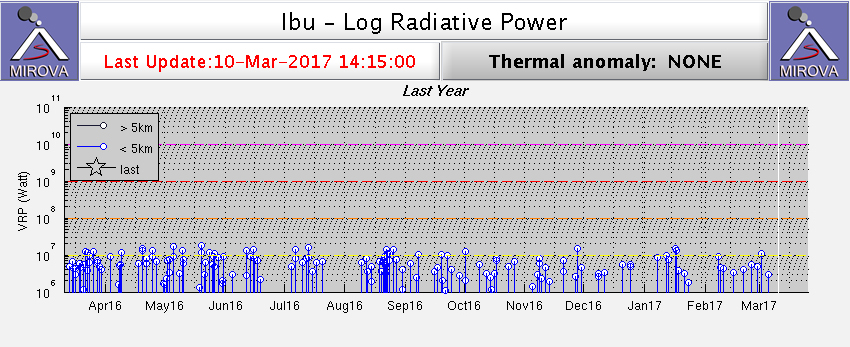Report on Ibu (Indonesia) — May 2017
Bulletin of the Global Volcanism Network, vol. 42, no. 5 (May 2017)
Managing Editor: Edward Venzke.
Research and preparation by Paul Berger.
Ibu (Indonesia) Dome growth and ash plumes continue during December 2015-March 2017
Please cite this report as:
Global Volcanism Program, 2017. Report on Ibu (Indonesia) (Venzke, E., ed.). Bulletin of the Global Volcanism Network, 42:5. Smithsonian Institution. https://doi.org/10.5479/si.GVP.BGVN201705-268030
Ibu
Indonesia
1.488°N, 127.63°E; summit elev. 1325 m
All times are local (unless otherwise noted)
Previously reported activity at Ibu through November 2015 included shallow seismicity, lava dome growth on the N part of the crater, and occasional white-to-gray plumes rising as high as 500 m above the summit (BGVN 40:11). This report, describing activity through early March 2017, is based on information from the Pusat Vulkanologi dan Mitigasi Bencana Geologi (PVMBG) and the Darwin Volcanic Ash Advisory Centre (VAAC).
During the reporting period (at least through 22 Aug 2016), the Alert Level remained at 2 (on a scale of 1-4) and the public was warned to stay at least 2 km away from the active crater, and 3.5 km away on the N side. Inclement weather often prevented visual observation.
According to PVMBG reports, similar activity to that previously described in 2013-2015 continued through at least 22 August 2016. Seismicity was dominated by signals indicating surface or near-surface activity, and the lava dome in the N part of the crater continued to grow. Occasional plumes (described variously as white-to-medium gray, gray-to-gray black, and ash) rose to altitudes of 1.5-2.4 km (200-1,100 m above the summit crater).
Thermal anomalies, based on MODIS satellite instruments analyzed using the MODVOLC algorithm, were observed infrequently during the reporting period. Hotspots were observed on seven days in December 2015, but only 1-3 days per month for subsequent months through March 2017. No hotspots were recorded during December 2016 and February 2017. In contrast, the MIROVA detection system recorded numerous anomalies between April 2016 and March 2017 (figure 10), almost all of which were at least 1 km from the volcano and of low power output.
 |
Figure 10. Thermal anomalies recorded at Ibu by the MIROVA system using MODIS infrared satellite data for the year ending 10 March 2017. Courtesy of MIROVA. |
Geological Summary. The truncated summit of Gunung Ibu stratovolcano along the NW coast of Halmahera Island has large nested summit craters. The inner crater, 1 km wide and 400 m deep, has contained several small crater lakes. The 1.2-km-wide outer crater is breached on the N, creating a steep-walled valley. A large cone grew ENE of the summit, and a smaller one to the WSW has fed a lava flow down the W flank. A group of maars is located below the N and W flanks. The first observed and recorded eruption was a small explosion from the summit crater in 1911. Eruptive activity began again in December 1998, producing a lava dome that eventually covered much of the floor of the inner summit crater along with ongoing explosive ash emissions.
Information Contacts: Pusat Vulkanologi dan Mitigasi Bencana Geologi (PVMBG, also known as Indonesian Center for Volcanology and Geological Hazard Mitigation, CVGHM), Jalan Diponegoro 57, Bandung 40122, Indonesia (URL: http://www.vsi.esdm.go.id/); Darwin Volcanic Ash Advisory Centre (VAAC), Bureau of Meteorology, Northern Territory Regional Office, PO Box 40050, Casuarina, NT 0811, Australia (URL: http://www.bom.gov.au/info/vaac/); Hawai'i Institute of Geophysics and Planetology (HIGP), MODVOLC Thermal Alerts System, School of Ocean and Earth Science and Technology (SOEST), Univ. of Hawai'i, 2525 Correa Road, Honolulu, HI 96822, USA (URL: http://modis.higp.hawaii.edu/); MIROVA (Middle InfraRed Observation of Volcanic Activity), a collaborative project between the Universities of Turin and Florence (Italy) supported by the Centre for Volcanic Risk of the Italian Civil Protection Department (URL: http://www.mirovaweb.it/).

